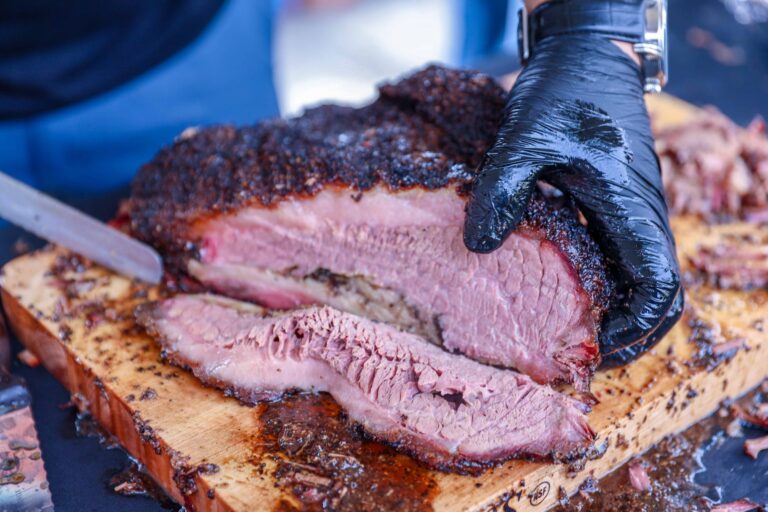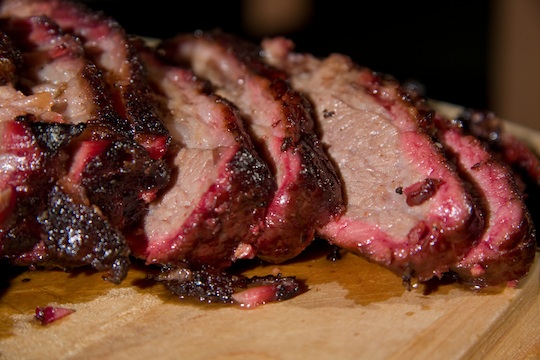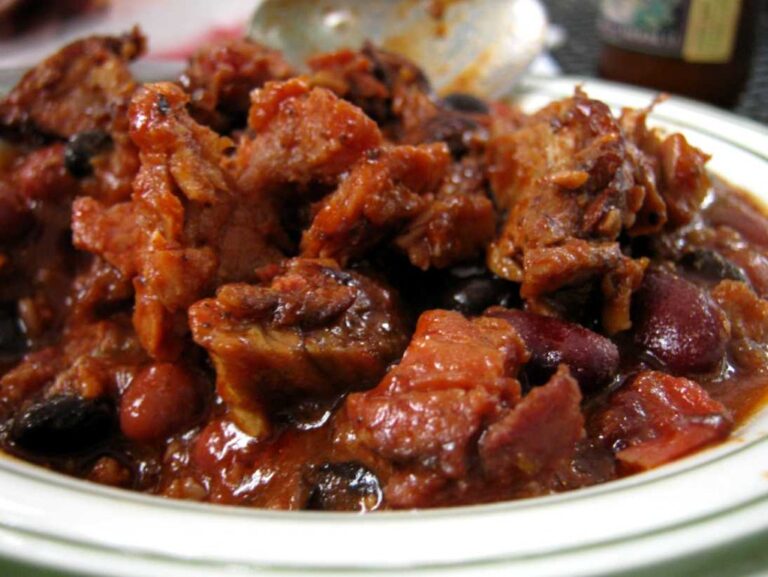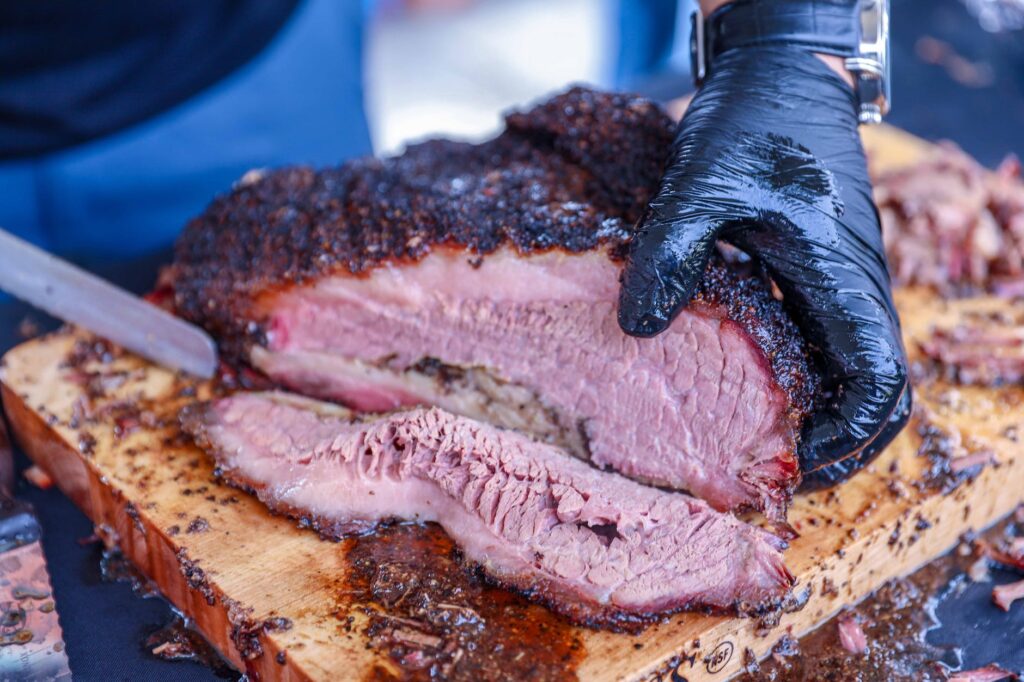Affiliate Disclaimer: This website uses affiliate links.That means that if you make a purchase using one of the links I may receive a small commission, at no additional cost to you. Commissions are what keep The Dadicurean up and running.


Editor's Pick
This recipe is ideal for those who want a flavorful, juicy brisket, without being overpowered with salt or black pepper.
Shopping list
Click on Each Link Below to Buy from Amazon
A Brief Rundown
If you’re like me you hate having to read through someone’s entire life story just to get a stupid recipe, so I won’t torture you with endless scrolling to get to the good part. All I am going to say is that I was introduced to the aforementioned Cattleman’s Grill “Original Cowboy Steak Seasoning” by the good folks at Champion’s BBQ Supply in Oklahoma City, and it has completely altered my expectations of what a brisket should taste like. The coffee in the rub gives the brisket a subtle chocolatey sweetness that mixes well with oakwood smoke, with just the right amount of seasonings to balance it out. I do have a pellet grill as my smoker, a Camp Chef Woodwind 36 inch with WiFi Controller to be exact, so if you have a pellet grill you can closely follow along, even if it’s not the same one. If not, the recipe works no matter what style of cooker you have, just substitute the fuel.
Brisket Recipe
Ingredients
Directions
- 1 Whole 18-20lb Brisket (USDA Prime preferred)
- 1-2 Shakers of Cattleman's Steak Seasoning
- 2 Cups Liquid (Broth, water, etc.)
- 1/3 Cup Kosmos Q Original Beef Brisket Injection
- Approximately 1/2 Cup Extra Virgin Olive Oil
- Evenly combine the oak and cherry pellets and fill the pellet grill hopper.
- Preheat grill to 220F (104.4C).
- Remove the brisket from the packaging and rinse under cold, running water to rinse off any liquid from the surface. Pat dry with a paper towel.
- Using a long, sharp knife, (boning knife preferred) trim away excess fat and hardened fat from the top and sides of the brisket. There is normally a deep, thick layer of fat that separates the Point from the Flat. You don’t need to worry about trimming that. Unless the fat cap on the backside of the brisket is greater than 1/4 to 1/2 inches thick, very little trimming will be needed.
- Add the brisket injection to the 2 cups of liquid until fully dissolved. For better dissolution of the mix, warm the liquid up in the microwave (do not boil) before adding
- Using a heavy duty meat injector, inject the solution into the brisket, focusing primarily on the Flat. Wipe away excess solution from the surface of the brisket.
- Flip the brisket over with the fat cap facing up. Rub with olive oil to create a binder and thoroughly cover with seasoning. Flip the brisket back over and repeat this process for the top of the brisket.
- Let the brisket rest for 20 minutes to allow the seasoning to bind to the meat.
- Place the brisket into the smoker, fat cap side down.
- Smoke until the Point of the brisket has reached an internal temperature of 170F (76.6C).
- Remove the brisket from the smoker and wrap completely in two layers of butcher paper, ensuring the folds rest under the fat cap and return to the smoker, fat cap side down.
- Continue to smoke until the Point has reached an internal temperature of 195F (90.5C).
- Remove brisket from the smoker and wrap in a towel, butcher paper and all.
- Rest the brisket in a cooler for 1-2 hours before serving.
Additional notes
Why Prime Over Choice?
For the uninitiated, USDA grades of Select, Choice, or Prime for beef have nothing to do with the wholesomeness of the meat, but rather a judgement of the meat’s tenderness, juiciness, and flavor. The bottom line, it’s all about how much intramuscular fat is marbled within the meat.
When it comes to the difference between Prime and Choice briskets, the real question is how much babysitting are you willing to do. Now for me, I like to put my brisket on the smoker at night before I go to bed let it go all night unattended until the morning when it’s close to the 170F mark. That’s why I go USDA Prime when I can help it. The higher fat marbling means the meat will be less likely to dry out. It’s really as close to a set-it-and-forget-grade as you can get.
Is a Choice OK? Sure, if it’s all you can find or if Prime is out of your price range. You’ll just have to keep an eye on it more to make sure the flat isn’t beginning to dry out. After the first three hours of smoking, spritz every 45 minutes or so with a liquid like apple juice, beef broth, or even water. Others have even suggested apple cider vinegar or Worcestershire (Wash-Your-Sister) sauce.
Sanitation is Key
It’s always a good idea to wear nitrile gloves and change them out frequently when handling raw meat to prevent accidental cross-contamination. While whole cuts of beef are generally considered to be less of a hazardous than raw chicken or pork, they can still carry dangerous levels of bacteria such as E. coli, Salmonella, and Yersinia, all of which can take you from enjoying a meal to praying to or riding the porcelain pony all night. Heavy duty gloves like the one below are a great option because they’re rugged and don’t tear as easily as more basic ones do. Lastly, when you’re all finished with the prep work and the brisket is on the smoker, go back to where you were working and disinfect any surface that may have come in contact with raw meat.
Choice of Flavorwoods
Oak is widely considered to be the flavorwood of choice when smoking a brisket. It is mild enough that it won’t overpower your food to the point where it’s inedible, making it perfect for a long smoke – And oak pellets are no exception. Plus, no one can resist the intoxicating aroma of oakwood smoke emanating from your backyard. So why add cherry? This really isn’t a make it or break it decision that will drastically effect the outcome of your brisket. Instead, a bag of cherry pellets is a great add-on to help generate a nice, dark smoke ring. One that will even impress your die-hard uncle who won’t give up his offset smoker. Besides, you will need about 40lbs of pellets anyway, so one bag of oak and one bag of cherry is the way to go. One flavor wood that gets brought up from time-to-time is mesquite. Now I love mesquite for steaks and chicken. (A reverse-seared steak that’s been smoked using mesquite is just out of this world.) However, those aren’t long smokes at all; maybe 30 minutes to an hour at most. Mesquite is just too powerful of a flavor wood to use as pellets for a long smoke. Even old-school offset smoke users would all a piece of mesquite unless it’s already been cooked down to a coal. Fresh mesquite or mesquite pellets WILL overpower the brisket, and it won’t be good either. If your pellet grill has a setting to increase smoke output, go ahead and crank that bisnitch up to maximum. If not, use a smoker tube for extra smoke flavoring. Use an electric heat gun to ignite the pellets.
Injection Techniques
While it’s important to focus on the Flat with the injection, it’s also important to not completely neglect the Point, as you want the flavor of the brisket to be as consistent as possible throughout, applying it around every 1-2 inches of brisket area. Another trick is to rest the brisket on an oversized baking sheet with lip around it so injection doesn’t spill out all over your countertop if it leaks from your brisket. To keep it from leaking out of the brisket too much, inject small amounts into the sides of the brisket. If don’t already have one, you’ll absolutely need a professional grade meat injector. The hole needle (the needle with holes up and down the stem) is ideal since it will distribute the injection laterally throughout the muscle and not just straight down. A good hack to make filling the injector easier to pour your injection solution into a tall, narrow glass first. This will allow the needle to get fully submerged in the solution with each draw until you start to run out.
Resting your brisket in a cooler does a couple things for you. The first, and most important thing that it does is that gives the brisket time sweat and re-absorb moisture, making it extra tender and delicious. Secondly, the temperature of the brisket will continue to climb another few degrees sitting in the cooler, so it will reach it peak serving temp during the resting time. This is why it’s importing in my opinion to remove it from the smoker while it’s at the 195F (90.5C) range. Removing it at 200F (93.3C) and resting it then means that the brisket could begin to dry out in the cooler because it’s getting too warm. When smoking a brisket, a few degrees here and there matter.
Resting & Serving
Serving up the Flat
When people think of eating slices of brisket, they are picturing slices of the flat. Getting a juicy Point is easy because it’s the thicker part and it’s got that thick band of fat under it, but getting a juicy flat is the mark of a person who’s got their brisket game on point. When slicing the brisket, the key is to slice against the grain of the meat so you can literally start to pull each slice apart from the sides.

Serving up the Point
The Point, or the thicker end of the brisket has many uses. On a Prime brisket though, there may be too much rendered intramuscular fat to try to try to slice it up without it falling apart on you like a pork shoulder, but this part is great for making barbecue beef sandwiches, barbacoa for street tacos or enchiladas, and of course, you can cube it up to make everybody’s favorite: burnt ends.

Final Thoughts
Did I miss anything? Please let me know.

